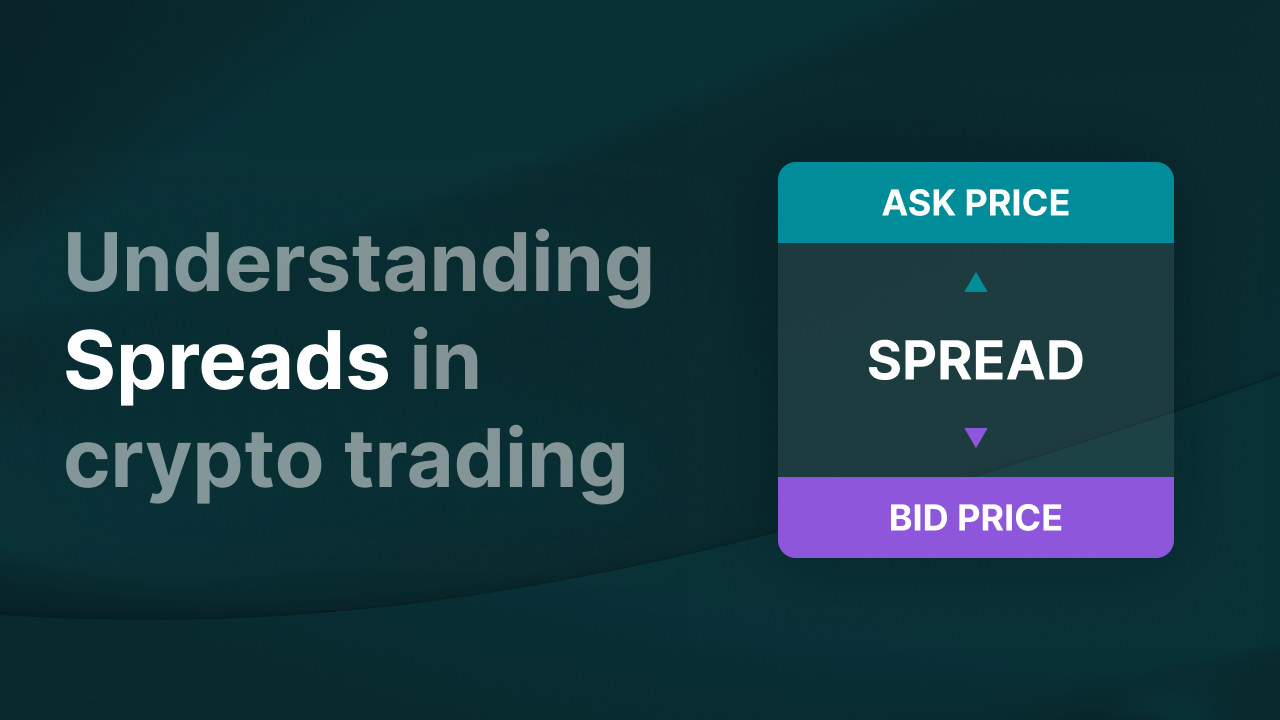Spreads no trading de criptomoedas: um guia completo

O que é um spread no trading de criptomoedas?
Um spread no trading de criptomoedas é a diferença entre o preço de compra (bid) e o preço de venda (ask) de uma criptomoeda. O preço de compra é o valor máximo que um comprador está disposto a pagar, enquanto o preço de venda é o mínimo que um vendedor aceita. Esta diferença representa um custo essencial na execução de uma operação e influencia diretamente a rentabilidade nos mercados financeiros e de criptoativos.
Exemplo:
Suponha que deseja comprar Bitcoin (BTC).
- O preço de compra é €29.950
- O preço de venda é €30.000
A diferença é o spread:
€30.000 - €29.950 = €50
Isso significa que, no momento da compra, já se encontra com uma “desvantagem” de €50 por Bitcoin. Se vendesse imediatamente, perderia esse valor apenas devido ao spread, sem contar as taxas de transação.
Pontos principais
- Um spread é a diferença entre o preço de compra (bid) e o preço de venda (ask) de uma criptomoeda. Representa um custo essencial nas operações.
- Existem diferentes tipos de spread: bid-ask, percentual, fixo e variável, que se ajusta à volatilidade do mercado.
- Spreads menores significam custos de trading mais baixos, fundamental para traders ativos.
- Os spreads são influenciados por fatores como liquidez, volatilidade, taxas de corretora, eventos macroeconómicos e atividade dos market makers.
- Spreads amplos podem indicar baixa liquidez ou mercados instáveis, gerando custos de entrada mais altos e slippage.
- É possível reduzir os custos com spread utilizando ordens limitadas, operando em horários de maior atividade e escolhendo criptomoedas com maior volume de negociação.
Tipos de spread no trading de criptomoedas
-
Spread bid-ask: O tipo mais comum. Representa a diferença entre o maior preço de compra e o menor preço de venda.
Por exemplo, se o Bitcoin tem um preço de compra de €30.000 e um de venda de €30.050, o spread é €50. -
Spread percentual: Expressa o spread como percentual do preço de venda. Exemplo: se o spread para o Ethereum é de €10 e o preço de venda é €2.000, o spread percentual é (10/2000) × 100 = 0,5 %.
-
Spread variável: Varia de acordo com as condições de mercado. Aumenta com a volatilidade e reduz-se em períodos de estabilidade. Depende da oferta, procura, liquidez e volatilidade, comum em plataformas com dados em tempo real.
-
Spread fixo: Determinado previamente por algumas plataformas. Não se altera com o mercado. É previsível, mas pode ser mais elevado em mercados calmos.
Como os spreads afetam o trading de criptomoedas?
Os spreads têm impacto direto nas estratégias e custos dos traders:
-
Custos de operação: O spread representa o custo para entrar e sair de uma posição. Spreads maiores significam custos mais altos, afetando os lucros, especialmente para traders ativos.
-
Indicador de liquidez: Spreads reduzidos indicam mercados líquidos, com facilidade para comprar ou vender sem afetar o preço. Spreads amplos sugerem baixa liquidez e alta volatilidade.
-
Impacto na execução de ordens: Em mercados agitados, os spreads tendem a aumentar, e a sua ordem pode ser executada a preços menos vantajosos, o chamado slippage.
Fatores que influenciam os spreads no mercado cripto
Diversos fatores afetam a amplitude dos spreads:
-
Liquidez de mercado: Mercados líquidos com alto volume de negociação tendem a ter spreads mais estreitos. Criptomoedas como Bitcoin e Ethereum geralmente apresentam spreads menores do que altcoins menos conhecidas.
-
Volatilidade: Movimentos bruscos de preço aumentam os spreads, pois os operadores procuram proteger-se de mudanças repentinas.
-
Eventos macroeconómicos: Decisões como alterações nas taxas de juros dos bancos centrais podem causar aumentos rápidos nos spreads.
-
Taxas de corretora: As plataformas aplicam diferentes modelos de taxas. Algumas incluem custos no spread; outras os cobram separadamente. Na Finst não cobramos spread e não operamos contra os nossos clientes, os nossos interesses estão totalmente alinhados com os seus.
-
Atividade dos market makers: Os market makers garantem liquidez através de operações constantes de compra e venda. A sua presença ajuda a manter spreads estreitos.
Estratégias para gerir os spreads
Aqui estão algumas dicas para controlar melhor os custos com spreads:
-
Escolher a corretora certa: Cada exchange tem spreads diferentes, influenciados pela liquidez, modelo de taxas e atividade dos market makers. Pesquise e opte por plataformas competitivas.
-
Analisar o livro de ordens: O livro de ordens de uma exchange mostra a liquidez do mercado. Muitos pedidos próximos significam spreads apertados; grandes lacunas indicam maior risco de slippage.
-
Monitorizar o mercado: Acompanhe o mercado e evite negociar durante eventos importantes ou alta volatilidade, se quiser minimizar os custos.
-
Usar ordens limitadas: Com ordens limitadas, define o preço exato de compra ou venda, ajudando a evitar spreads amplos.
-
Negociar nos horários de pico: Os spreads tendem a ser mais reduzidos quando os mercados da Europa e dos EUA estão abertos simultaneamente, altura de maior liquidez.
-
Escolher criptomoedas populares: Moedas com alta procura, como Bitcoin e Ethereum, normalmente apresentam spreads menores, reduzindo os custos operacionais.
Considerações finais
Compreender o funcionamento dos spreads no trading de criptomoedas é essencial para otimizar os lucros e reduzir custos. Ao conhecer os fatores que influenciam os spreads e aplicar estratégias adequadas, os traders podem tomar decisões mais informadas. Seja iniciante ou experiente, estar atento aos spreads e ajustar a sua abordagem às condições do mercado permitirá negociar de forma mais eficiente e segura.
